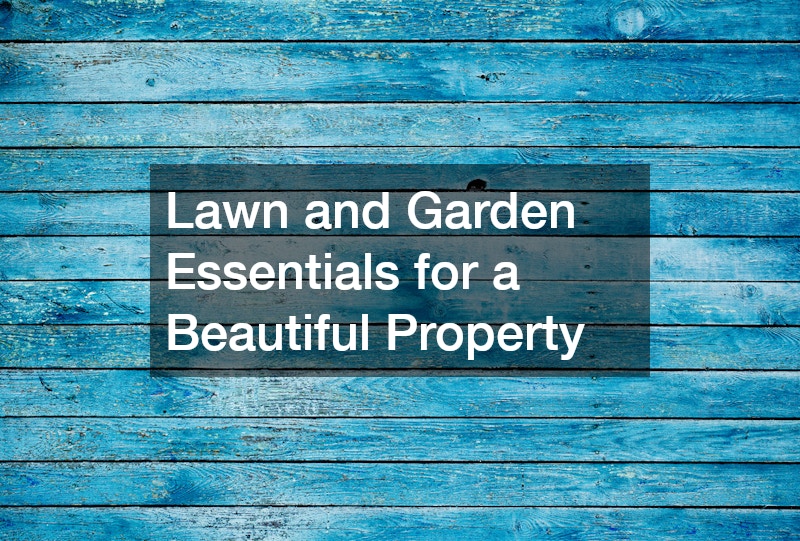

A beautiful property starts with a healthy, vibrant lawn and garden—one that reflects both care and thoughtful planning. The outdoor areas of your home are often the first impression guests or potential buyers notice, and well-maintained greenery can significantly boost curb appeal, property value, and your own enjoyment of the space. Whether you’re a seasoned green thumb with years of experience or a beginner just digging into the world of outdoor care, understanding the essential elements of lawn and garden maintenance is the foundation for success.
It’s more than just watering your plants or mowing the lawn. True lawn and garden excellence involves a deeper knowledge of soil health, the right tools for each task, seasonal plant selection, and proactive pest management. You’ll also want to incorporate environmentally friendly techniques to conserve water, reduce chemical use, and promote a more sustainable landscape.
What Are the Basic Tools Needed for Lawn and Garden Maintenance?

Essential Gardening Tools
Every successful garden begins with the right set of hand tools. Trowels, hand forks, cross docking, and durable garden gloves are the backbone of effective gardening. These tools are used for planting, weeding, and cultivating small flower beds or vegetable patches. Investing in high-quality stainless steel tools with ergonomic grips ensures they last through multiple seasons.
Lawn Care Equipment
Lawn care is much more than just mowing your grass. It involves keeping the entire turf healthy and well-manicured. In addition to a reliable lawnmower—available in manual, electric, and gas-powered models—you’ll need leaf rakes, lawn spreaders for seeding and fertilizing, and string trimmers for edging around walkways. For larger properties, commercial-grade equipment may be beneficial. Consider finding a reputable utility equipment repair. Some trucking companies even offer delivery of bulk lawn supplies or large tools for rural or commercial estates. A shipping container can make a great storage solution for lawn care equipment.
Tools for Soil Health
Healthy soil is the foundation of any thriving garden. Tools such as soil aerators, cultivators, and garden forks help loosen compacted earth, improve drainage, and prepare planting beds. For raised garden beds, simple hand-operated aerators are sufficient, but for larger areas, powered versions are available for rent. Forklift rental services, often used in warehousing and construction, can also assist with moving heavy soil amendments or pallets of compost for large-scale landscaping jobs.
Specialized Pruning Tools
Maintaining trees and shrubs requires specialized tools like pruning shears, loppers, and pole saws. These tools help manage plant size, promote healthy growth, and remove dead or diseased branches. For large pruning projects, especially in commercial landscaping or estates, using powered pole pruners or chainsaws may be necessary. Some fleet services companies even provide maintenance plans for this type of equipment to ensure it’s always in peak condition.
Power Tools for Efficiency
Power tools such as hedge trimmers, leaf blowers, and rototillers significantly reduce manual labor and increase efficiency. Homeowners with large properties or busy schedules benefit greatly from these investments. These tools are available for purchase or through rental services—an economical choice for infrequent tasks. If you’re dealing with commercial garden installations or maintaining multiple properties, storing and transporting tools efficiently becomes crucial, much like managing warehouse racking systems that maximize space and improve workflow. Power tools have gotten more affordable with advances in metal parts manufacturing.
How Do I Improve Soil Quality for Optimal Plant Growth?
Understanding Soil Composition
Before planting, it’s important to understand the type of soil you have—clay, sandy, loamy, or a mix. Each type has distinct characteristics affecting water retention, aeration, and nutrient availability. A balanced soil structure supports strong root systems and healthy plant growth.
Testing and Analyzing Soil
Soil testing kits or professional services help determine pH levels and nutrient deficiencies. Local cooperative extensions often provide low-cost testing and recommendations for amendments. Based on the results, you may need to add specific fertilizers, lime, or sulfur to correct imbalances.
Using Organic Matter and Compost
Incorporating organic matter like compost, manure, and mulch enhances soil structure, increases microbial activity, and improves moisture retention. Large gardens may require bulk compost deliveries, and working with trucking companies can ensure timely and cost-effective transport of these materials.
Balancing pH Levels
Most plants prefer a pH between 6.0 and 7.0. Adjusting the pH with lime (to raise) or sulfur (to lower) ensures optimal nutrient uptake. Regular testing and amendments keep your garden in balance throughout the seasons.
Tips for Maintaining Nutrient-Rich Soil
Crop rotation, green manure crops, and regular composting replenish nutrients and reduce soil fatigue. Avoid over-fertilizing, as this can harm beneficial soil organisms and lead to runoff problems. Sustainable soil care requires a consistent, long-term strategy.
What Are the Best Plants for My Garden?
Choosing Plants Based on Climate
Select plants suited to your local hardiness zone to ensure they thrive with minimal care. Native plants are particularly advantageous because they’re adapted to local soil and weather conditions, making them more resilient and less water-dependent. Some garden centers may have a cold storage facility for speciality plants.
Flowering Plants for Colorful Gardens
Bright, blooming flowers like tulips, marigolds, and roses add visual appeal. Choose perennials for long-lasting displays or annuals for seasonal bursts of color. Combine heights and colors to create dynamic flower beds.
Vegetables and Herbs for Culinary Use
Vegetable gardens not only beautify your space but also provide fresh, organic produce. Tomatoes, peppers, lettuce, basil, and parsley are beginner-friendly and productive. Raised beds and container gardens are ideal for urban settings.
Low-Maintenance Plant Options
Consider drought-tolerant or slow-growing plants for easy care. Ornamental grasses, succulents, and ground covers like creeping thyme or sedum reduce the need for constant upkeep and watering.
Creating a Seasonal Planting Schedule
A seasonal plan ensures your garden remains vibrant year-round. Spring and summer focus on planting and growth, while fall emphasizes pruning and soil preparation. Winter is ideal for planning and equipment maintenance.
How Do I Water My Lawn and Garden Efficiently?
Understanding Plant Water Needs
Different plants have different water requirements. For instance, succulents need very little water, while leafy vegetables and flowers often require consistent moisture. Understanding individual plant needs helps avoid overwatering or underwatering.
Irrigation Systems and Drip Lines
Installing an irrigation system can significantly streamline watering. Drip lines deliver water directly to plant roots, reducing waste and promoting deep root growth. Smart systems with timers allow precise control and conserve water.
Timing and Frequency of Watering
Early morning or late evening is best for watering to reduce evaporation. Avoid shallow watering, which encourages weak roots. Instead, water deeply and less frequently for more resilient plants.
Water Conservation Techniques
Rain barrels, mulching, and soil amendments improve moisture retention and reduce water use. Choose drought-resistant plants for regions prone to dry spells.
Detecting Overwatering or Underwatering
Signs of overwatering include yellowing leaves, root rot, and fungus. Underwatered plants wilt, dry out, and drop leaves. Monitor soil moisture regularly to catch issues early.
How Can I Control Weeds Naturally?
Identifying Common Weed Types
Common garden weeds include dandelions, crabgrass, and chickweed. Learning to identify them helps in choosing the most effective removal method.
Natural Herbicides and Alternatives
Vinegar-based sprays, salt solutions, and boiling water can eliminate weeds without harming the environment. These are best applied directly to weeds to avoid damaging nearby plants.
Techniques for Mulching
Mulching suppresses weed growth by blocking sunlight. Organic mulch also decomposes over time, enriching the soil. Be sure to apply mulch at the proper thickness for maximum benefit.
Hand Pulling and Manual Removal
Manual removal is labor-intensive but effective for small gardens or isolated weeds. Ensure you remove the entire root to prevent regrowth.
Preventative Measures for Weed Control
Regular mowing, soil cultivation, and proper spacing of plants minimize weed opportunities. Healthy, dense plantings also reduce the space available for weed seeds to take hold.
What Techniques Can I Use to Prune My Plants?

Pruning Tools and Safety
Basic pruning tools include bypass pruners, loppers, and saws. Always sanitize tools before use to prevent disease spread. Use safety gear, especially when working with thorny or tall plants.
Understanding Growth Cycles
Prune according to the plant’s growth cycle. Spring bloomers should be pruned after flowering, while summer and fall bloomers benefit from early spring pruning.
Shaping and Aesthetic Pruning
Pruning for shape enhances visual appeal and prevents overcrowding. Remove deadwood and selectively thin branches to maintain structure.
Timing for Optimal Pruning
Late winter or early spring is ideal for most pruning. Avoid pruning during active growth or flowering unless removing dead or diseased wood.
Avoiding Common Pruning Mistakes
Over-pruning weakens plants and may prevent flowering. Use sharp, clean tools, and make cuts at the right angles to promote healing.
How Do I Foster a Healthy Lawn?
Grass Types and Their Benefits
Choose the right grass for your climate—cool-season grasses like fescue thrive in northern regions, while warm-season types like Bermuda are best in the south. The right type reduces maintenance and improves durability.
Lawn Mowing Best Practices
Mow regularly and adjust the blade height seasonally. Avoid cutting more than one-third of the grass height in one mowing session to prevent stress and browning.
Aeration Techniques and Benefits
Aeration relieves soil compaction, allowing air, water, and nutrients to penetrate roots. Use a core aerator for best results, and schedule during the growing season.
Fertilization Tips for Robust Growth
Use a slow-release fertilizer to promote steady growth and reduce the need for frequent applications. Apply in early spring and fall for best results.
Disease and Pest Prevention Strategies
Monitor your lawn for signs of disease, such as brown patches or fungus. Aerate, fertilize properly, and water efficiently to discourage pests and pathogens.
What Are Effective Pest Control Methods?
Common Garden Pests and Symptoms
Aphids, beetles, and caterpillars are among the most common garden pests. Symptoms include discolored leaves, stunted growth, and visible damage.
Integrated Pest Management (IPM)
IPM combines cultural, biological, and mechanical methods to manage pests sustainably. Regular monitoring, habitat management, and beneficial insects play key roles.
Organic and Chemical Control Options
Organic solutions like neem oil and insecticidal soap are effective against many pests. Use chemical treatments as a last resort and always follow label instructions.
Attracting Beneficial Insects
Ladybugs, lacewings, and bees control pests naturally. Planting flowers like marigolds and daisies can attract these helpful allies to your garden.
Traps and Barriers as Preventive Tools
Sticky traps, row covers, and physical barriers can protect plants from insects and animals. These methods are especially useful in vegetable gardens.
How Can I Design an Eco-Friendly Garden?
Importance of Native Plants
Native plants require less water, fertilizer, and maintenance, making them ideal for eco-friendly gardens. They also support local wildlife and pollinators.
Water-Wise Landscaping Tips
Incorporate drought-tolerant plants, mulch, and efficient irrigation systems. Design with contours and swales to capture and redirect rainfall.
Composting and Waste Reduction
Composting kitchen scraps and garden waste reduces landfill use and enriches soil. Use compost bins or tumblers to speed up the process.
Sustainable Gardening Practices
Rotate crops, avoid synthetic fertilizers, and use organic pest control methods. These practices protect the environment and produce healthier plants.
Encouraging Biodiversity
Diverse plantings attract a range of insects, birds, and animals, creating a balanced ecosystem. Include a mix of flowers, shrubs, and trees.
What Are the Benefits of Mulching?

Different Types of Mulch
Mulch types include bark, wood chips, straw, and gravel. Organic mulch improves soil over time, while inorganic mulch is low maintenance.
Mulching Techniques for Different Plants
Mulch trees and shrubs in wide rings, and use lighter mulch for vegetables. Avoid piling mulch against stems to prevent rot.
Controlling Temperature and Moisture
Mulch insulates soil, keeping it cool in summer and warm in winter. It also reduces evaporation, helping plants retain moisture.
Weed Suppression with Mulch
Mulch blocks light, preventing weed seeds from germinating. Replenish regularly to maintain a thick, even layer.
Boosting Soil Health Through Mulching
As organic mulch decomposes, it adds nutrients and improves soil texture. This encourages healthy root development and plant growth.
Final Thoughts
Equipped with the right tools, techniques, and knowledge, you’re now prepared to cultivate a lush lawn and flourishing garden that enhances your property’s beauty and value. From soil care to pest control, and from eco-friendly designs to efficient lawn care strategies, every element works together to support a healthy outdoor environment. Whether you’re managing a small backyard or coordinating larger spaces with help from trucking companies, fleet services, or forklift rental providers for material transport, the essentials discussed here will guide you toward long-term success. And for those looking to organize gardening supplies efficiently, systems like warehouse racking can streamline storage and improve access, making every task that much easier.


